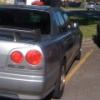Help With Fitting Size And Thread Pitch
Announcements
-
Similar Content
-
Latest Posts
-
Hey mate. I've had this on my list of things to do for a while, but got stumped by the bracket / ECU situation and haven't had time to look at it properly. Would love to see photos of what you achieved to give a better guideline on how to approach this.
-
What are they. Some sort of knock-off Sumitomo copy? Or originals "reconditioned"? Do they come with pins and springs and anti-rattle/squeal plates, or are you going to have to spend almost as much again getting those too? I also have no idea if the hoses on the 34NA will suit those, and if they don't, what hoses you would need to buy, or perhaps get made, to make it work.
-
Read my post above. It tells you what to do.
-
Hello everyone, haven't signed in for years! But here i am again 😂… anyways, i am planning to order these calipers on ebay with the z32 rotors and pads… that would be everything i need to upgrade my ER34 Gt non turbo Coupe?? thank you! What about the mounting bolts? Same? Is there a difference between z32 calipers like turbo and non turbo? … so i can get the correct rotors and pads









Recommended Posts
Create an account or sign in to comment
You need to be a member in order to leave a comment
Create an account
Sign up for a new account in our community. It's easy!
Register a new accountSign in
Already have an account? Sign in here.
Sign In Now